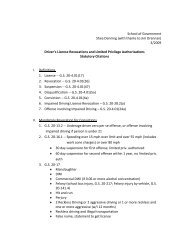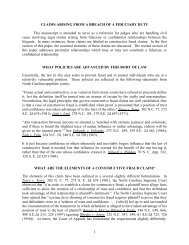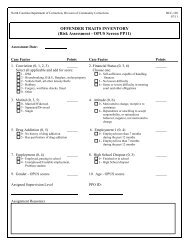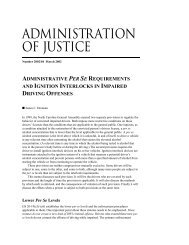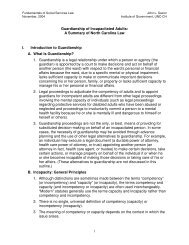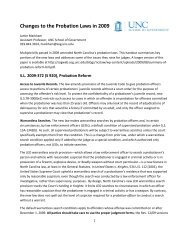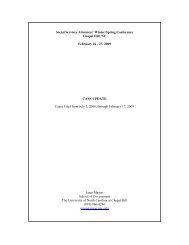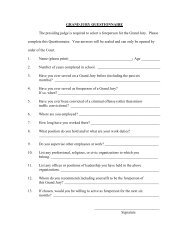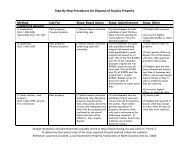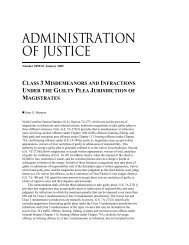Post-Construction Ordinance
Post-Construction Ordinance
Post-Construction Ordinance
You also want an ePaper? Increase the reach of your titles
YUMPU automatically turns print PDFs into web optimized ePapers that Google loves.
Mecklenburg County<br />
<strong>Post</strong>-<strong>Construction</strong> Storm Water<br />
<strong>Ordinance</strong><br />
1. <strong>Ordinance</strong> Goals<br />
2. <strong>Ordinance</strong> Development Process<br />
3. Proposed <strong>Ordinance</strong> Standards<br />
4. Town & County <strong>Ordinance</strong>s
Waters of Mecklenburg<br />
Our Most Precious Natural Resource<br />
Davidson<br />
Cornelius<br />
Huntersville<br />
Charlotte<br />
Mint Hill<br />
Pineville<br />
Matthews
Non-Point Source Pollutants<br />
…of water<br />
pollution in<br />
Mecklenburg<br />
County.<br />
Sediment<br />
Bacteria<br />
Toxic & Mineral<br />
Metals<br />
Pesticides<br />
Fertilizers<br />
Petroleum Products<br />
Storm water<br />
runoff is the<br />
biggest source…
Catawba<br />
Cornelius<br />
(2005)<br />
Huntersville<br />
(2005)<br />
Charlotte<br />
(1993)<br />
Davidson<br />
(2005)<br />
Yadkin<br />
Mint Hill<br />
(2005)<br />
Urbanized<br />
areas must<br />
obtain storm<br />
water permits<br />
that require<br />
the control of<br />
storm water<br />
pollutants.<br />
Pineville<br />
(2005)<br />
Matthews<br />
(2005)
Storm Water<br />
Permit Requirements<br />
Public Education and Outreach<br />
Public Involvement & Participation<br />
Illicit Discharge Detection/Elimination<br />
<strong>Construction</strong> Site Runoff Control<br />
<strong>Post</strong> <strong>Construction</strong> Site Controls<br />
Pollution Prevention/Good Housekeeping
Control non-point source pollutants, volume and velocity<br />
during post-construction.<br />
Deadline for County & Towns: July 1, 2007<br />
Deadline for City of Charlotte: July 1, 2009
Joint Stakeholder Process by County, Towns & City<br />
Prior to the initiation of the ordinance development process, staff<br />
identified the goals they felt needed to be met by the ordinance.
<strong>Ordinance</strong> Goals (Staff)<br />
Ensure compliance with all Federal and State requirements associated<br />
with providing water and sewer services and protecting water quality in<br />
our growing community.<br />
1. Achieve compliance with the Phase I and Phase II<br />
NPDES Storm Water Permit requirements.<br />
2. Satisfactorily address the pollution control<br />
criteria specified by NCWRC & USFWS for the<br />
Yadkin Basin.<br />
3. Satisfactorily address the causes of impairment<br />
identified in the N.C. 2002 Integrated 305(b) and<br />
303(d).<br />
4. Satisfactorily address detention measures for the<br />
control of storm water volumes and peaks.
1. Achieve compliance with Storm<br />
Water Permit requirements.<br />
• Manage storm water runoff from new<br />
development and redevelopment that<br />
disturb an acre or more of land surface.<br />
• Ensure controls are in place to minimize<br />
water quality impacts (State sets minimum<br />
requirements).<br />
• Provide a mechanism to require long term<br />
operation and maintenance of control<br />
measures.
2. Satisfactorily address the pollution control<br />
criteria recommended by Wildlife agencies<br />
Catawba<br />
Yadkin<br />
Goose<br />
Creek<br />
Six Mile<br />
Creek<br />
Carolina heelsplitter:<br />
Endangered Species of<br />
Freshwater Mussel
Good (Natural Condition)<br />
Bad (Impacted by Development)<br />
1. Limit impervious cover to 10% and less.<br />
2. Maintain pre-development hydrograph.<br />
3. Undisturbed buffers ranging up to 200 feet.
Impacts of the Heelsplitter<br />
• Permits are required to provide water & sewer.<br />
• Permits can’t be issued until EA / EIS results in FONSI.<br />
• Wildlife agencies must be satisfied to reach FONSI.<br />
• No FONSI = No water & sewer.<br />
• <strong>Post</strong>-<strong>Construction</strong> <strong>Ordinance</strong> is meant to satisfy Wildlife agencies.<br />
• Examples of Heelsplitter impacts to date:<br />
- Franklin WTP expansion<br />
- FERC Authorization to increase water withdrawal from MIL<br />
- 3-County WWTP<br />
- IBT Increase certification<br />
- McDowell Creek WWTP expansion<br />
- Reedy / McKee Creek sewer outfall<br />
-McAlpine Creek Relief Sewer<br />
-Reissuance of County & Towns’ Phase II Permit
Sugar Creek<br />
Catawba<br />
ba River Basin<br />
Legend<br />
Charlotte<br />
Cornelius<br />
Davidson<br />
Huntersville<br />
Matthews<br />
Mint Hill<br />
Pineville<br />
McDowell Creek<br />
Long Creek<br />
Little Sugar Creek<br />
Irwin Creek<br />
Rocky River<br />
Clarks Creek<br />
73% of major streams are<br />
impaired.<br />
McAlpine Creek<br />
3. Satisfactorily address the causes<br />
of water quality impairment.<br />
The primary source<br />
of impairment is<br />
storm water Catawba runoff Basin Yadkin Basin<br />
Yadkin River Basin from Irwin new Creek McKee Creek<br />
development.<br />
Stewart Creek Rocky River<br />
Yadkin<br />
McKee Creek<br />
Goose Creek<br />
Clear Creek<br />
N Fork Crooked Creek<br />
N<br />
Taggart Creek<br />
Coffey Creek<br />
Kings Branch<br />
Sugar Creek<br />
Briar Creek<br />
Little Sugar Creek<br />
McMullen Creek<br />
Four Mile Creek<br />
McAlpine Creek<br />
Long Creek<br />
McDowell Creek<br />
McCullough Branch<br />
Clarks Creek<br />
Crooked Creek<br />
Clear Creek<br />
Goose Creek
Implications of Stream<br />
Impairment<br />
Storm Water Permits require the<br />
restoration of impaired waters.
4. Satisfactorily address detention measures for<br />
the control of storm water volumes and peaks.
• An inch of rainfall on an acre of woods in typical piedmont soils<br />
produces no runoff.<br />
• The same one inch of rainfall on one acre of asphalt will produce<br />
over 27,000 gallons of runoff.
Volume + Velocity = Change in Natural Stream<br />
Hydrology
14 feet<br />
Channel Instability
Mayfly<br />
Increased Turbidity
Flooding
Hiring of a Consultant<br />
In March 2004 prior to the initiation of the stakeholders’<br />
process, a private consultant (Tetra Tech) was hired to:<br />
1. Develop a county-wide water quality model.<br />
– Identify current water quality conditions.<br />
– Set a baseline of water quality conditions to meet four (4)<br />
goals.<br />
– Predict future conditions based on land use plans.<br />
– Identify the gap between current conditions, future<br />
conditions and the baseline for goal compliance.<br />
– Test ordinance scenarios developed by the stakeholders’<br />
group and identify associated costs for closing the gap<br />
between future conditions and the baseline.<br />
– Confirm ordinance compliance with the four (4) goals.<br />
2. Provide technical support during stakeholder deliberations.<br />
3. Ensure that the ordinance is scientifically sound.
<strong>Ordinance</strong> Goals (Stakeholders)<br />
1. Cost feasibility<br />
2. Political feasibility<br />
3. Administrative feasibility<br />
4. Consistent with community values
<strong>Post</strong>-<strong>Construction</strong> <strong>Ordinance</strong><br />
Development Process<br />
April 22, 2004 through September 22, 2005<br />
Goal: To utilize a stakeholders’ process to reach<br />
consensus on ordinance language to be considered<br />
for adoption by elected officials for the purpose of<br />
controlling storm water runoff in compliance with<br />
the four (4) previously stated goals.
Stakeholder Representation<br />
Dale Stewart<br />
Mark Loflin<br />
Tim Mead<br />
Amy Ringwood<br />
Steve Wilson<br />
Rich Keagy<br />
Dan Latta<br />
Dan Duval<br />
Tim Bahr<br />
Curtis Trenkelbach<br />
Lindsey Hobbs<br />
Mark Cramer<br />
Rick Roti<br />
Merrie Salvo<br />
Roy Alexander<br />
Marc Houle<br />
Jim Bowen<br />
Charlotte Chamber<br />
Char-Meck Planning Commission<br />
Charlotte Property Owner<br />
Charlotte Property Owner<br />
CMU Advisory Committee<br />
Home Builders Association<br />
Home Builders Association<br />
Marine Commissions<br />
NAIOP/ Commercial Board of Realtors<br />
NAIOP/ Commercial Board of Realtors<br />
Northern Towns<br />
REBIC<br />
Sierra Club<br />
Southern Towns<br />
Storm Water Advisory Committee<br />
Subdivision Steering Committee<br />
UNC-Charlotte
<strong>Ordinance</strong> Development Process<br />
Stakeholders were provided training and information<br />
prior to the initiation of the consensus building process.<br />
Phase I: Assess current & future water quality conditions<br />
September 22, 2005: Reached full consensus – no minority report.<br />
and compare to goals. How wide is the gap? November 2004<br />
Phase II: Use water quality modeling to evaluate alternative<br />
management scenarios for closing the gap. February 2005<br />
Phase III: Translate the selected management scenario into<br />
ordinance language. September 2005
Checking for Compliance with Goals<br />
Modeling performed by a Tetra Tech confirmed the<br />
following regarding the stakeholders’ ordinance:<br />
• Fulfills all four (4) of the goals established by staff<br />
• Addresses the stakeholder goals better than any of the<br />
scenarios tested by:<br />
– Significantly reducing costs while achieving the four<br />
(4) primary goals.<br />
– Allowing for more politically feasible.<br />
– Providing for flexibility in design and implementation<br />
and allowing for planned growth.<br />
– Better addressing community values.
<strong>Post</strong>-<strong>Construction</strong> <strong>Ordinance</strong><br />
• Applicability & Exemptions<br />
• Administrative Manual<br />
• Design Manual<br />
• Storm Water Management Permit<br />
• Storm Water Administrator<br />
• Appeals & Variances<br />
• Standards<br />
• Mitigation<br />
• Open Space<br />
• Maintenance<br />
• Enforcement
N<br />
LAKE<br />
NORMAN<br />
ROCKY<br />
RIVER<br />
CENTRAL CATAWBA<br />
WESTERN CATAWBA<br />
YADKIN-SOUTHEAST CATAWBA<br />
GOOSE CREEK<br />
HUNTERSVILLE<br />
LOWER<br />
MTN<br />
ISLAND<br />
UPPER<br />
MTN<br />
ISLAND<br />
McDOWELL<br />
GAR<br />
LONG<br />
CLARKE<br />
MALLARD<br />
LOWER<br />
CLARKE<br />
<strong>Post</strong>-<strong>Construction</strong><br />
<strong>Ordinance</strong> Districts<br />
BACK<br />
CATAWBA<br />
BEAVERDAM<br />
LAKE<br />
WYLIE<br />
STEELE<br />
PAW<br />
SUGAR<br />
IRWIN<br />
UPPER<br />
LITTLE<br />
SUGAR<br />
LOWER<br />
LITTLE<br />
SUGAR<br />
BRIAR<br />
McMULLEN<br />
REEDY<br />
McALPINE<br />
FOUR MILE<br />
CLEAR<br />
GOOSE<br />
CROOKED<br />
TWELVE MILE<br />
McKEE<br />
CALDWELL<br />
1. Most powerful<br />
consensus<br />
building tool.<br />
2. Provides<br />
significant<br />
flexibility.<br />
CLEM<br />
SIX MILE<br />
5 0 5 10 Miles
Criteria for Meeting Goals<br />
1. Structural BMPs<br />
2. Buffers<br />
3. Detention<br />
4. Open Space
Structural BMPs<br />
Structural BMPs are Wetland<br />
required Pond<br />
at between 10% & 24%<br />
BUA with either 85% Rain TSS Garden removal or both 85% TSS &<br />
70% TP removal depending on the Watershed District.<br />
Collect runoff and remove pollutants.
Buffers<br />
S.W.I.M. plus 30-foot no build zone on intermittent<br />
streams except Yadkin buffers at 50 feet for<br />
intermittent and 100 feet for perennial or floodplain.<br />
Buffers filter pollutants before<br />
they enter surface waters.
Detention<br />
Required based on BUA – Control volume for 1-yr,24-hr<br />
storm – Control peak for 10-yr & 25-yr, 6-hr storms or for<br />
residential perform downstream analysis; for commercial<br />
control 10-yr, 6-hr storm and downstream analysis<br />
Reduce volume and velocity of storm water runoff.
Open Space - Trees<br />
Varies from 10% to 25% based on BUA – Greater BUA<br />
less Open Space<br />
Filter pollutants and reduce impervious area.
Mitigation<br />
• The purpose of mitigation is to allow<br />
flexibility in the administration of the<br />
<strong>Ordinance</strong> and reduce compliance costs<br />
while providing an equal or greater<br />
protection of water quality.<br />
• Applications/notifications must be submitted<br />
for all forms of mitigation.<br />
• If approved, mitigation is valid for three (3)<br />
years.<br />
• If denied, full compliance with the <strong>Ordinance</strong><br />
is required.
Types of Mitigation<br />
1. TP Mitigation<br />
• Off-Site Option<br />
• Buy-Down Option<br />
2. Development & Redevelopment Mitigation<br />
• Buy-Right Mitigation Payment<br />
3. Undisturbed Open Space Mitigation<br />
• On-Site Option<br />
• Off-Site Option<br />
• Payment-In-Lieu Option<br />
• Pre-Approved Options
Local Design Manual Goals<br />
Completed in June 2007<br />
• At least as protection as State Manual.<br />
• Consider local conditions.<br />
• Meet all post-construction goals.<br />
• Recognize treatment train benefits.<br />
• Provide design options (flexibility).
Local Design Manual Goals<br />
Completed in June 2007<br />
• Use existing monitoring data with<br />
ability to incorporate future data.<br />
• Easily implemented by the private<br />
development community.<br />
• Easily reviewed by local regulatory<br />
staff.
September 8, 2006<br />
• Commend the proposed measures in the<br />
Yadkin-Southeast Catawba Watershed<br />
District and believe that Charlotte and<br />
Mecklenburg County should adopt this<br />
ordinance.<br />
• More protective measures needed in Goose<br />
and Six Mile Creeks where the Carolina<br />
heelsplitter is known to exist.
N.C. Division of Water Quality<br />
June 2007: State approval received for all the Towns<br />
and County<br />
“The Division of Water Quality has reviewed the Phase<br />
II <strong>Post</strong>-<strong>Construction</strong> ordinance and believes that the<br />
ordinance, in conjunction with the technical design<br />
storm water specifications found in the Charlotte-<br />
Mecklenburg local storm water Best Management<br />
Practices 9BMP) Design Manual, collectively meet the<br />
requirements of the Phase II storm water program.”
Town & County <strong>Ordinance</strong>s - June 30, 2007<br />
• Cornelius: Modified stakeholder ordinance with<br />
only one district, no open space, no TP removal<br />
and Catawba buffers throughout.<br />
• Davidson: Stakeholder ordinance.<br />
• Huntersville: Updated existing LID <strong>Ordinance</strong> to<br />
comply with Phase II requirements. More<br />
protective than stakeholder ordinance.<br />
• Matthews: Stakeholder ordinance.<br />
• Mint Hill: Modified stakeholder ordinance with 3<br />
districts and changes to Yadkin buffers.<br />
• Pineville: Stakeholder ordinance.<br />
• Mecklenburg County: Stakeholder ordinance.
City of Charlotte<br />
Reconvened Stakeholders’ Group for Additional Information<br />
September & October 2007
?<br />
For a copy of ordinances and other information:<br />
http://stormwater.charmeck.org (select “<strong>Post</strong>-<strong>Construction</strong> Storm Water Programs”)



